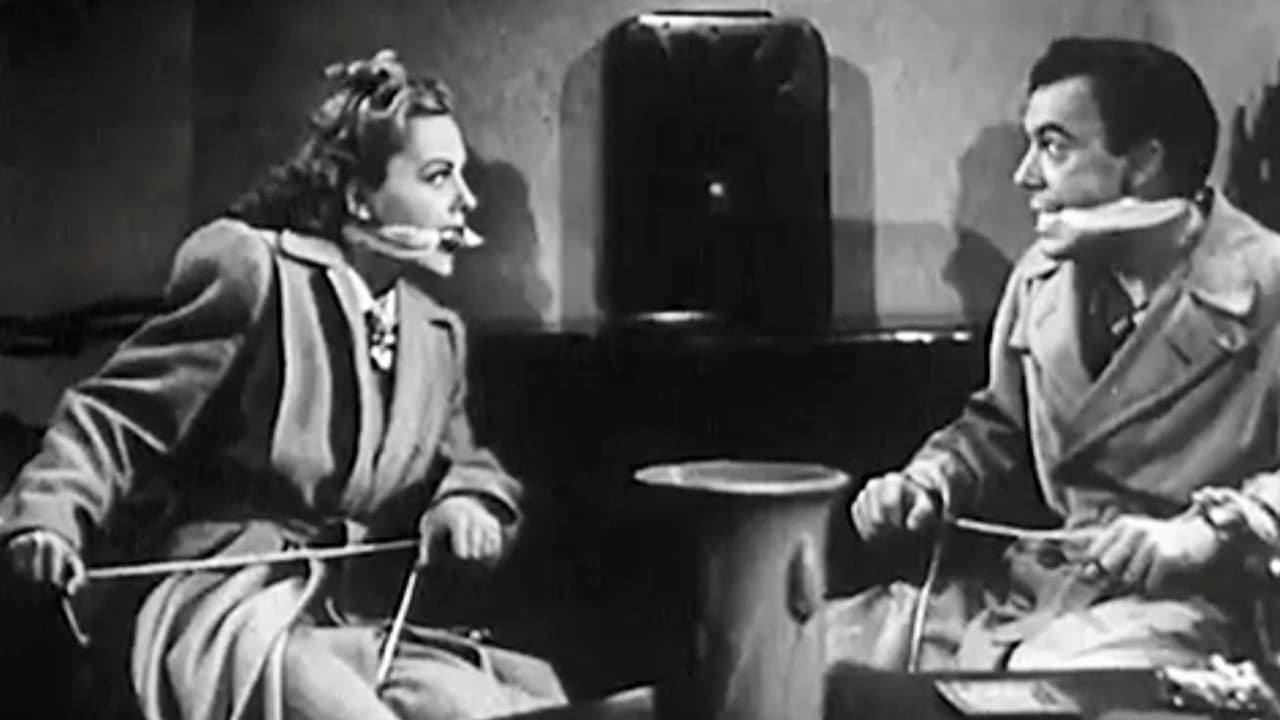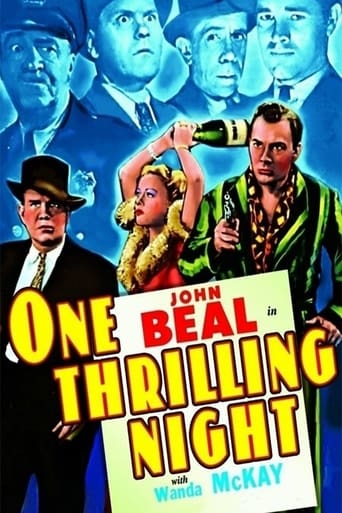

"One Thrilling Night" is a likable film that is anything but a good picture! Yes, it's cheap, the characters are all total morons and the plot dopey...yet it's will oddly enjoyable.The film begins when Horace (John Beal) and Millie (Wanda McKay*) arriving in the big city for their honeymoon. Soon, they find someone in their bed and he appears dead. When they call for the house detective, however, the guy disappears! In fact throughout the film, the body of this gangster appears and disappears. And a group of incredibly stupid crooks think Horace is the man they knocked out. The cops get involved...and they are stupid as well. Well, now that I think about it, EVERYONE is incredibly dumb in this film and the filmmakers really overdo this. Yet, oddly, despite the dopiness of everyone and the situation, the film is strangely enjoyable in a brain-dead sort of way. A silly time-passer.*FYI--While McKay never went on to become a top actress, she did become Mrs. Hoagy Carmichael and remained married to him many years until his death.
... View MoreWar draftee John Beal and his bride Wanda McKay check into a New York hotel for one quick night of marital bliss before he heads off to fight the Japanese but end up with so much more thanks to an alleged corpse Beal finds in their bed. This results in an adventure as they deal with kidnappers, idiotic house detectives (Warren Hymer once again) and a night in the Big Apple they'll never forget. Comedy, intrigue, action and brilliant character bits make this tons of fun, as put together by the quick filming William Beaudine, "King of the One Take".Among the amusing sequences are the couple's winning the big prize in a movie theater raffle while they are trying to remain hidden from the villains (very obviously present), Beal's come-on by their moll Barbara Pepper (the original "Mrs. Ziffel") and McKay's sudden heroic attack on the villains. You can see many future similar plots in this, particularly in the two higher budgeted plots of the "Fuller Brush" movies. Future film noir heavy Tom Neal ("Detour") is prominently featured as the main villain.
... View MoreMonogram combined it's standard lowbrow crime/action with comedy for this film, which is a bit weak on the comedy side. It has it's moments, but you can't help but think the situation is ridiculous. A newlywed couple with only a day before the husband is shipped off to service in WWII chooses to travel instead of doing what a newlywed, presumably virgin couple with only a day would actually do. There is a subtext of lustful desire being thwarted, but it is obviously muted due to the era.Through no fault of their own they get mixed up with gangsters who have been in their hotel room trying to kill enemies. Mix-ups with a missing body, police ineptitude and misidentification of the groom as gangster kingpin keeps this running for most of the film. This might have worked better with a cast and director who could pull it off, but it falls a bit flat here, though not entirely.It has classic elements of 1930s screwball comedy, though a little late for Monogram in 1942 to begin cutting their chops. It's fun as a period piece, but far from great cinema.
... View MoreIn this instance, it be. The trade papers seldom had anything good to say about product from the minors for a couple of reasons; there was seldom anything good to say about it, and since the minors spent little in the way of advertising money in the trades, the reviewers got a free shot at expressing how they really felt without being called to task by the editor or publisher because Louis B. Mayer didn't like their comments. "One Thrilling Night" actually had a premier showing at a Hollywood theatre as opposed to the trade reviewers dropping by the studio screening room to see it or, as was often the case, being reviewed at a theatre months after it was released. Monogram was not high on the "trades" priority list. It was screened on June 28, 1942 and, ordinarily, it would have been released a few days before or afterwards. The reviews were so out of the norm, that the film was held back long enough for all an all-new pressbook and posters and ad mats to be made incorporating the reviews and the release was held up until August 8, 1942. "Boxoffice" said if it had come from a major company, it would be loudly and quickly acclaimed as a "sleeper"; "Film Daily" called it clever, fast and fautlessly played---as good as anything Monogram ever turned out; David Hanna, in the L.A. Daily News, said it was one of the most creditable films ever to come from Monogram and augered well for the future of this alert and enterprising studio; in a rather breezy fashion, "Motion Picture Daily's" reviewer tabbed it a sleeper and advised to give it some racing room at the head of the stretch as it had speed, a style of its own and finished strong; and "Showmen's Trade Review" called the direction of William Beaudine like a cut gem with no situation that interferes with another. Yadda, Yadda, Yadda also from "Variety" and "Movie-Radio Guide. Hold on one cotton-picking moment, what is going on here? All this about a film directed by William (One-Shot) Beaudine; produced by A. W. Hackel of the Supreme (company name, not a description) westerns with Bob Steele and Johnny Mack Brown circa 1934-1936 and father of some exploitation pics only a notch above those from Kroger Babb and the widow Houdini; a film with the dour and dull John Beal, usually found playing a preacher in the limberlost, doing a comedy turn and B-western and serial regulars such as Ernie Adams, Lynton Brent and Pierce Lyden playing funny gansters? Well, dang if the reviewers weren't about half right, albeit slightly overboard probably from being somewhat giddy and surprised at finding this behind the Monogram logo and over-reacted. All in all, well worth finding and watching and, maybe, being surprised. And Wanda McKay, as the frustrated bride, in a 1942 silk slip with one strap hanging didn't hurt it none nuther.
... View More